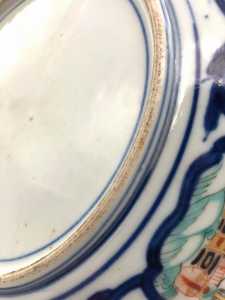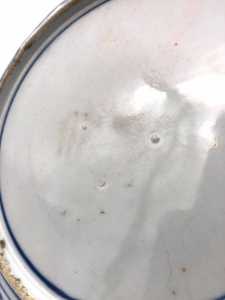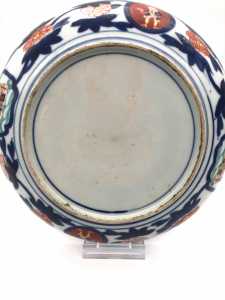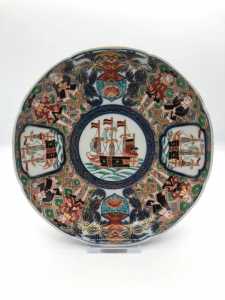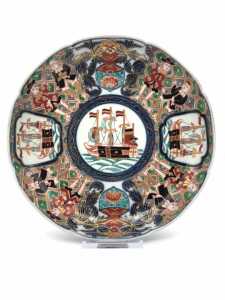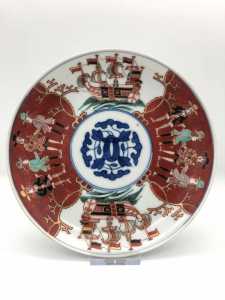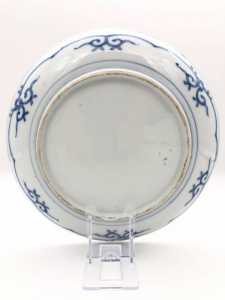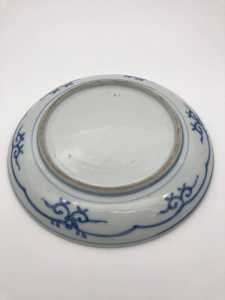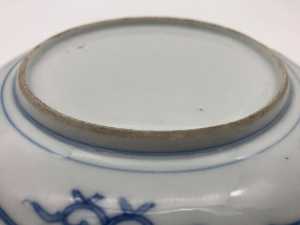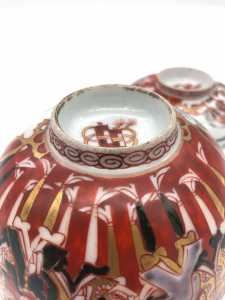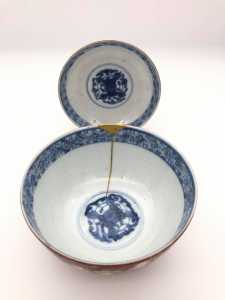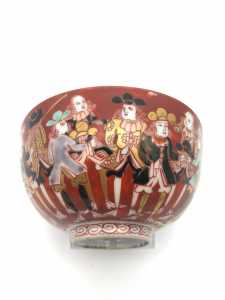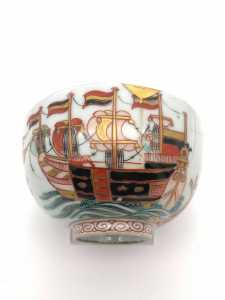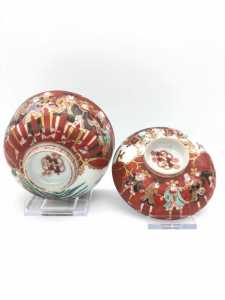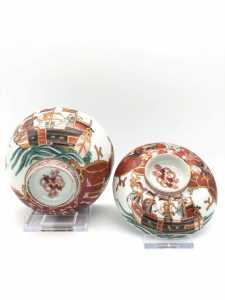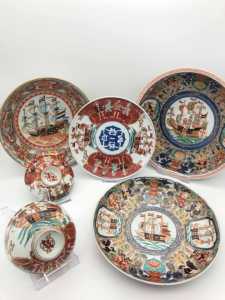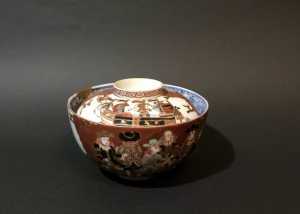The Chinese and Asian Art Forum. For Fans, Collectors and Dealers.
 Basic Rules For the BidAmount Asian Art Forum: Talk about whatever you want. You can even discuss and offer things that are for sale if they are authentic. Maximum image file size per post is 2 MB. Images of 700pxl x 700pxl are optimal if saved at a medium resolution. Be respectful of others and enjoy yourself. Click the YouTube link for a brief tutorial on using the forum. You can also EMBED Videos by cutting and pasting from You-Tube, Vimeo etc.
Basic Rules For the BidAmount Asian Art Forum: Talk about whatever you want. You can even discuss and offer things that are for sale if they are authentic. Maximum image file size per post is 2 MB. Images of 700pxl x 700pxl are optimal if saved at a medium resolution. Be respectful of others and enjoy yourself. Click the YouTube link for a brief tutorial on using the forum. You can also EMBED Videos by cutting and pasting from You-Tube, Vimeo etc.
NOTE: To post an item or add a new post, click open the category title from the FORUM LIST, and CLICK the Blue ADD TOPIC button.
Hi all,
I have acquired three more "black ships" pieces, and one left me scratching my head a bit. It has three spur marks, but two of the spur marks are sanded down and there are many scratches surrounding those two. Were genuine spur marks ever sanded down in this manner? Could this be a fake, intended to deceive? or would this have been something done later on by another owner?
I'll add photos of the other pieces for your perusal before I send them to Peter for IDing, and update later on. I believe the two plates to be Meiji with doubts about the first one, and the rice bowl to be early Meiji, hopefully, late Edo. The second plate I believe to be Daishoji Imari, given its sharply beveled foot rim. This sharply beveled foot rim seems to be the one common quality to the questionable field of Daishoji Imari, so I thought it would be helpful for reference for the forum given it's been brought up before, although I do hope Michael sees this and verifies my thoughts on it.
#1) "Spurious" Spur Marks? Given the central ship does not fill the circle tightly, and the faces of the sailors are crudely painted, I believe the earlier this could be is Meiji, but likely later.
#2) Daishoji Imari with Sharply Beveled Footrim
#3) Rice Bowl - Given the decently painted dutchmen, and the kintsugi repair, I believe this could be Edo.
Bonus photo of the collection so far...
As usual, thanks for looking!
John
Hi John,
I wouldn’t worry about the spur marks, they look fine. All your lovely pieces look 19th century to me. Will leave it to the more knowledgable to narrow that down. I am not sure kintsugi can be used for dating, as its still employed to the present day, but I could be wrong. Congratulations!
Todd
take it with a grain of salt
Hi Todd,
Thanks for your input! It's reassuring to hear that the spur marks look fine. It reminded me of the way people scratch out China mark, like they're trying to hide something. In this case, I thought maybe they were trying to hide poorly done spurs or something similar. Also, thanks for your insight on kintsugi! I think you're right, and that I placed too much weight on that repair to judge its age.
John
Also, I forgot to mention that I've never seen that mark before on the rice bowl and cover. They look like two scrolls. Has anyone else?
Hi John,
In my opinion the two plates are Japanese and from the Meiji period.
The two bowls with the unusual scroll like mark is a mystery to me. I have seen this before but I can't remember exactly what it was etc. I tried looking it up without success.
I will ask my friend what he thinks. He has a enormous database.
Regards,
Mark
Hi Mark,
Thank you for your insight! I am glad there's a consensus with the two plates. Also, thank you for sending the bowl over to your friend. I look forward to hearing back!
John
John, you are building quite a collection. It is looking great! Are the 2 new bowls a chawan?
I will be interested to hear what Mark finds out. I wonder if the mark is related to the other gold marks one sometimes sees on the reverse. They are a similar style. I tried to find one but only got this from worthpoint. Does one of yours have this mark? I am sure I have seen it recently.
https://images.app.goo.gl/FwF4Z9h5tMF71k8P8
Hi Julia,
Thank you for your kind words! On the two bowls, I really should have taken a photo of it closed. I think it's a rice bowl and lid. Here's a photo of it together:
You're right about the mark being closely related to the "kotobuki" mark you linked, too! The large Edo period bowl in the back right of the group photo has the "kotobuki" mark and it's it's the same gilt over iron red as the scroll mark. I believe that mark means "celebration" and was not used to signify a maker. Similarly, maybe the scrolls could be some other auspicious symbol rather than signifying a maker.
John
@bartholin Congratulations, you are cornering the market on black ships. I second Todd about not worrying about the spur mark, any former owner with their handy dremel could have smoothed it to keep from scratching or catching. Sharon
Hi Sharon,
Thank you for your input on spur marks and your kind words! I'm having a lot of fun hunting for this pattern. I am shooting for every reasonably priced piece I see, but I've also had to have more discipline in other areas of my collection now.
John
@barholin
Hi John -
Not really my area but three very nice pieces, my congratulations on acquiring ...
The ‘double scrolls with tied ribbons’ base mark originated in China, one of numerous ‘auspices emblems’ used in decoration and adopted by Japanese painters ...
Stuart
Hi Stuart,
Thank you for providing that background on the double scrolls with the tied ribbons and your kind words! It's interesting that the mark is influenced by the Chinese. I wonder if that would make it an earlier dating rather than the more recent Meiji era. It doesn't seem to be nearly as prolific as the "Kotobuki" mark that can even be found on contemporary pieces. Very interesting!
John
Hi Todd,
Thanks for taking a second look at the rice bowl! I'm feeling pretty optimistic about it. I usually don't place much emphasis on the marks for dating, but it looks like this one could be something more. I wonder what Peter will think!
John
Hello John,
Good to see you are still collecting and finding good examples. I think dating theses Black Ship Imari Items and placing their place of origin is very difficult. As far as spur marks are concerned my reading on the subject leads me to believe that small neat spur marks which are low in number 3 or less, that look like little pimples date to after 1870. By 1870 the Meiji ethic of great Japan and export or die was gaining momentum very large sums of capital had to be raised to purchase not only the western chemicals and dye's, but also modern western type kilns and kiln furniture. Methods of production had to be changed the 100's of small village type kilns in the Hizen district, which includes Arita and Kutani started to amalgamate. Improvements to infrastructure roads, bridges etc made it easier for people to move about. Prior to the Meiji ordinary people had to gain permission from their local Daimyo to leave their village, these restrictions were gradually lifted during the Meiji. This meant that skilled workers could move around and take their skills and what was previously a distinct style associated with one particular place to other areas. All of which makes it very difficult to actually pin point a place of production for our items. Dating can be a bit easier if we can identify if the glazes are pre or post the 1870's, what kiln furniture was used can help. But you have to bear in mind that not all the small Kilns managed to make all the changes immediately so it might be fair to say small neat spur marks indicate post 1870's you should not assume large ugly spur marks are pre 1870's.
All of the items in your latest post look to my eye to be Kutani type production, thinness of the walls of the pots, color of the glazes and shape of the foot rim and all date after the 1870's but that is just a guess for the reasons stated above.
As you are aware Dasihoji is a problem that is unresolved with many experts having different opinions. The debate has been going on for a long time have included a link to Asian Art forum going back to 2004. Personally in my own collecting I have decided to forget about Dasihoji until a scholarly book gets written based on scientific analysis.
Have included a couple of links for items sold by major auction houses. Suggest you read as much as possible on the Nanban trade as possible and look at the prints , paintings and screens and leather and laqure trunks and note how the figures are painted. The older the item the more exaggerated are the depictions of the westerners clothing extremely wide and bulbous breeches for example. Over time these features became less exaggerated.
Thanks for keeping us updated with your collection, in the group photo the one in the top row at the right hand side appeals to me. Look forward to hearing Peters opinion when you have it.
Michael.
https://www.bonhams.com/auctions/24763/lot/39/?category=list
Thank you, Michael!
You've provided some interesting pieces of information that I thought were helpful. I hadn't come across that Asian Art forum thread before, so it was interesting to see the debate isn't new but has also picked up recently. I think I'll follow in your footsteps and move forward with a skeptical eye towards Daishoji Imari.
I'll also keep your handy spur marks insight in mind whenever I see them in the future! Also, if you remember which book, do you mind sharing where you've read about that? No worries if not, as I often forget where I read certain things.
Also, thank you for providing the big auction houses links. The Bonhams one in particular looks interesting to me. Peter said in his last evaluation that the ships filling the center circle was one hint it could be Edo, if all other things look right with some exceptions. I would've thought that the Bonhams one would've been Edo based on that rule alone, but looking at the pieces as a whole makes me agree with their Meiji dating. The less exaggerated clothes, as you point out, but also the teal cloudy outlines within the "armorial" design on the border, as Sharon once put it, and the use of yellow enamels for the flowers rather than gilt. I'll be looking more into this comparative analysis, although my observations are always assuming the dating of the pieces I hold are correct.
In addition, you have a good eye, Michael! The far back right bowl you pointed out is the bowl I posted previously that Peter ID'ed as Edo period 1800-1820.
Separately, in this area, there seems to be two separately identifiable variations: (1) the group of dutchmen on a red ground opposite a black ship panel, and (2) the central black ship design with a flowered diaper motif on the cavetto. The former seems to have a wider color palette for the westerner's clothing with teals and aubergines, whereas the latter seems to stick to the red, black, and gilt palette. I wonder if these two separate variations originate from a certain kiln, if one kiln stuck to one variation, or whether all kilns that produced this pattern produced each variation.
Kindly,
John
Thanks for visiting "The BidAmount Asian Art Forum | Chinese Art"
If you sell on eBay, or have a shop feel free to post images and descriptions and links.
Check back often for discussion about the latest news in the Chinese art and antique world. Also find out about the latest Asian art auctions at Sotheby's, Christie's, Bonhams and Tajans.
Auction results for: fine porcelain, ceramics, bronze, jade, textiles and scholar's objects. As well as Japanese, Thai, Vietnamese and other Asian cultures.
Thank you,
Peter Combs
Topics and categories on The BidAmount Asian Art Forum | Chinese Art
Kangxi vases, Kangxi dishes and chargers, Kangxi ritual pieces, Kangxi scholar's objects, Qianlong famille rose, Qianlong enamels, Qianlong period paintings, Qianlong Emporer's court, Fine porcelain of the Yongzheng period. Chinese imperial art, Ming porcelain including Jiajing, Wanli, Xuande, Chenghua as well as Ming jades and bronzes.
The BidAmount Asian Art Forum | Chinese Art
A free Asian art discussion board and Asian art message board for dealers and collectors of art and antiques from China, Japan, Korea, Thailand, Cambodia, Vietnam and the rest of Asia. Linked to all of the BidAmount Asian art reference areas, with videos from plcombs Asian Art and Bidamount on YouTube. Sign up also for the weekly BidAmount newsletter and catalogs of active eBay listing of Chinese porcelain, bronze, jades, robes, and paintings.
The art of calligraphy - and for the ancient Chinese it certainly was an art - aimed to demonstrate superior control and skill using brush and ink. Calligraphy established itself as one of the major Chinese art forms during the Han dynasty (206 BCE - 220 CE), and for two millennia after, all educated men were expected to be proficient at it.
The Museum’s collections of Asian art span nearly five millennia and encompass the cultures of China, the Himalayas, India, Japan, Korea, and Southeast Asia. In 2007, the Museum launched an initiative to create dedicated galleries for the collection, beginning with a gallery for the arts of Korea ...
Chinese art is full of symbolism, in that artists typically seek to depict some aspect of a totality of which they are intuitively aware.
China Online Museum is the finest online museum of Chinese art. It features Chinese calligraphy, painting, ceramics, bronzes, carving, and other artworks.
Chinese Ceramics & Works of Art. Overview Upcoming auctions Contacts Auction results ... Christie’s sales of Chinese ceramics and works of art showcase centuries of Chinese history. Held throughout the year in London, New York, Paris and Hong Kong, they attract a wide audience of collectors and connoisseurs vying for pieces as diverse as ...
Explore Asian Art Week. Contact the Specialist Department. Chinese Paintings ... Senior Specialist, Head of Sale. [email protected]. Tel:+1 212 641 5760. Bid in-person or online for the upcoming auction:Fine Chinese Paintings on 10 September 2019 at New York. Bid in-person or online for the upcoming auction:Fine Chinese Paintings on 10 ...
Discover an abundance of must-see art from all corners of a vast continent at Christie’s NY Asian Art Week. From contemporary classical and Chinese paintings to works with exemplary provenance from the Art Institute of Chicago, our Rockefeller Paza galleries will be full of ancient treasures and contemporary masterworks in a salute to the vibrant arts of Asia.
Sold to benefit The Art Institute of Chicago’s Asian Art Acquisition Fund, the sale features 84 lots with a focus on Ming and Qing porcelains, and offers a rare insight into the taste for collecting Chinese ceramics and works of art in the Midwest from the end of the 19th century through the 1980s. Highlights include two Wanli wucai garlic-head vases, a Qianlong mark and period, blue and ...
Specialist, Chinese Paintings, Christie's London Dr Malcolm McNeill is a Specialist in Chinese Paintings at Christie’s, based in London. He previously worked as an assistant curator of the Chinese collections and the Victoria and Albert Museum in London, as a researcher at the British Museum, and as a translator and tour guide at the National Palace Museum in Taipei.
The Christie's Education 2020 Conference: The Chinese Art Market 18 Jun 2019 Christie’s Education is delighted to announce our first international academic conference in Asia which will take place in Hong Kong from 26-27 November 2020 at the Hong Kong Convention and Exhibition Centre and will run in parallel with Christie’s Hong Kong Autumn Auctions.
The summer Chinese Art sale in Hong Kong will feature works of art from several private collections, including Qing porcelains and textile from the collection of the legendary Chinese art dealer A. W. Bahr (1877–1959), fine gilt bronze Buddhist sculptures from an old Hong Kong collection, an East Asian collection of Qing dynasty wine cups and jades, and a Japanese collection of Song ceramics ...
Sotheby's Chinese Works of Art Department holds two auctions each year in London, New York, Hong Kong and Paris.
Chinese Art - View Auction details, bid, buy and collect the various artworks at Sothebys Art Auction House.
With more than 340 Chinese works of art dating from the Neolithic to the Republic periods, highlights of this sale include a selection of Qing Imperial monochromes from the collection of Arnold and Blema Steinberg, early ceramics from the Art Institute of Chicago and Chinese porcelain and works of art from the collection of Henry Arnhold.
Results: Sotheby's Asia Week achieved $52.4 million in six strong auctions, exceeding pre-sale estimates. With 76.5% of lots sold and 60.3% of lots surpassing high estimates, the Asian art sales at Sotheby's indicate continued collector interest in the finest works of art from China, India and and the Himalayas.
Today's sale of Important Chinese Art will proceed as planned with sessions at 10 AM and 2 PM EDT. Sotheby's will be monitoring the weather conditions throughout the day and will be available to coordinate alternative bidding options should conditions make it difficult for clients to attend the auction in person.
Bonhams Chinese Art department is renowned for offering the finest works of art representing the richness and breadth of China's artistic heritage, particularly Imperial porcelain, white and spinach green jades, cloisonné and Buddhist art. Specialised international auctions are held globally, including London, Hong Kong and San Francisco.
Bonhams : Chinese Works of Art We use cookies to remember choices you make on functionality and personal features to enhance your experience to our site. By continuing to use our site you consent to the use of cookies. Please refer to our privacy and cookie policies for more information.
Bonhams Fine Art Auctioneers & Valuers: auctioneers of art, pictures, collectables and motor cars. We use cookies to remember choices you make on functionality and personal features to enhance your experience to our site. By continuing to use our site you consent to the use of cookies. ... Chinese Art (US) General enquiries
Bonhams : Fine Chinese Art We use cookies to remember choices you make on functionality and personal features to enhance your experience to our site. By continuing to use our site you consent to the use of cookies. Please refer to our privacy and cookie policies for more information.
Bonhams Fine Art Auctioneers & Valuers: auctioneers of art, pictures, collectables and motor cars Bonhams : Asian Art We use cookies to remember choices you make on functionality and personal features to enhance your experience to our site.
Bonhams are international auctioneers of fine Chinese and Japanese art. We specialise in rare Imperial and Export Chinese ceramics and works of art, as well as Japanese ceramics, fine and decorative works of art from the Neolithic Period to the 20th century. View on map
Bonhams Fine Art Auctioneers & Valuers: auctioneers of art, pictures, collectables and motor cars. We use cookies to remember choices you make on functionality and personal features to enhance your experience to our site. By continuing to use our site you consent to the use of cookies. ... Asian Art Bonhams. Work. 22 Queen St.
